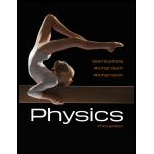
Concept explainers
(a)
The work function of the metal.
(a)
Answer to Problem 96P
The work function of the metal is
Explanation of Solution
Given that the
Write the expression for the magnitude of the magnetic force on the electron when it enters perpendicular into the field.
Here,
The magnetic force is providing the necessary centripetal force for the motion of the electron. Thus, the magnetic force can be equated to the centripetal force on electron.
Here,
Solve equation (II) for
Write the expression for the maximum kinetic energy of the ejected electron.
Here,
Write the expression for the maximum kinetic energy of the ejected electron in terms of the work function of the metal.
Here,
Equate the right hand sides of equations (IV) and (V) and solve for
Use equation (III) in (VI).
Conclusion:
Substitute
Therefore, the work function of the metal is
(b)
Whether the electrons with maximum kinetic energy follow a path with the maximum or minimum radius.
(b)
Answer to Problem 96P
The electrons with maximum kinetic energy follow a path with the maximum radius.
Explanation of Solution
Equation (IV) indicates that the maximum kinetic energy of the electron is directly proportional to the square of the speed of the electrons.
Equation (III) indicates that the speed of the electron is directly proportional to the radius of the circular path.
Hence, it can be summarized that the maximum kinetic energy of the electron corresponds to the large value of the radius. Thus, The electrons with maximum kinetic energy follow a path with the maximum radius.
Conclusion:
Therefore, the electrons with maximum kinetic energy follow a path with the maximum radius.
Want to see more full solutions like this?
Chapter 27 Solutions
Student Solutions Manual for Physics
 College PhysicsPhysicsISBN:9781305952300Author:Raymond A. Serway, Chris VuillePublisher:Cengage Learning
College PhysicsPhysicsISBN:9781305952300Author:Raymond A. Serway, Chris VuillePublisher:Cengage Learning University Physics (14th Edition)PhysicsISBN:9780133969290Author:Hugh D. Young, Roger A. FreedmanPublisher:PEARSON
University Physics (14th Edition)PhysicsISBN:9780133969290Author:Hugh D. Young, Roger A. FreedmanPublisher:PEARSON Introduction To Quantum MechanicsPhysicsISBN:9781107189638Author:Griffiths, David J., Schroeter, Darrell F.Publisher:Cambridge University Press
Introduction To Quantum MechanicsPhysicsISBN:9781107189638Author:Griffiths, David J., Schroeter, Darrell F.Publisher:Cambridge University Press Physics for Scientists and EngineersPhysicsISBN:9781337553278Author:Raymond A. Serway, John W. JewettPublisher:Cengage Learning
Physics for Scientists and EngineersPhysicsISBN:9781337553278Author:Raymond A. Serway, John W. JewettPublisher:Cengage Learning Lecture- Tutorials for Introductory AstronomyPhysicsISBN:9780321820464Author:Edward E. Prather, Tim P. Slater, Jeff P. Adams, Gina BrissendenPublisher:Addison-Wesley
Lecture- Tutorials for Introductory AstronomyPhysicsISBN:9780321820464Author:Edward E. Prather, Tim P. Slater, Jeff P. Adams, Gina BrissendenPublisher:Addison-Wesley College Physics: A Strategic Approach (4th Editio...PhysicsISBN:9780134609034Author:Randall D. Knight (Professor Emeritus), Brian Jones, Stuart FieldPublisher:PEARSON
College Physics: A Strategic Approach (4th Editio...PhysicsISBN:9780134609034Author:Randall D. Knight (Professor Emeritus), Brian Jones, Stuart FieldPublisher:PEARSON





